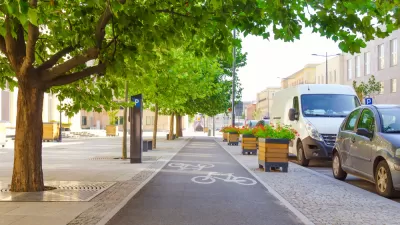As home delivery of everything from groceries to furniture becomes more popular, policymakers must evaluate how to keep streets safe and accessible for pedestrians and other vulnerable users.

In a piece on NJfuture.org, Tim Evans ponders the role of goods delivery in the Complete Streets model. "How should we be thinking about the safety of pedestrians and other non-motorized travelers in an era of increasing truck traffic?," Evans asks.
In New Jersey, goods movement is a major industry, accounting for one in eight jobs. Meanwhile, the growth of e-commerce, accelerated by the pandemic, has led to a sharp rise in delivery services and truck traffic. "In recognition of the increasing visibility of freight movement on New Jersey’s highways, roads, and streets, the Federal Highway Administration (FHWA) and the New Jersey Department of Transportation (NJDOT) recently hosted a workshop entitled 'Freight in our Neighborhoods: Toward a More Complete Street.'"
While some may question why 'complete streets' would even include trucks, the reality is that deliveries must happen. But "Introducing large trucks onto local streets that were designed for smaller vehicles, and where pedestrians are frequently present, creates numerous problems." To that end, "The purpose of the FHWA/NJDOT workshop was to raise the issue of how to balance the need to deliver goods to people and local businesses with the needs of other users of local streets, particularly those not inside vehicles."
Evans outlines the different options that delivery services and cities have for accommodating new demand for home delivery while maintaining safe, accessible streets for all users. "Rather than proposing truck-focused modifications (wider lanes, bigger turning radii, etc.) to local streets in order to accommodate truck deliveries, transportation planners and logistics industry professionals should focus instead on matching the type of delivery vehicle to the environment in which the destination is located."
"If goods are increasingly being shipped directly to people’s homes rather than changing hands at suburban retail complexes to which people drive their own vehicles, then local streets need to be prepared to accommodate delivery vehicles in addition to private automobiles." Even smaller vehicles will need space to stop and make deliveries, writes Evans.
As Complete Streets advocates make their case for improving pedestrian safety and addressing the needs of diverse road users, "The relatively recent increase in the popularity of home delivery means that addressing freight movement on local streets is very much a live issue."
FULL STORY: “Complete Streets” and Goods Delivery: What Is a Street For?

Maui's Vacation Rental Debate Turns Ugly
Verbal attacks, misinformation campaigns and fistfights plague a high-stakes debate to convert thousands of vacation rentals into long-term housing.

Planetizen Federal Action Tracker
A weekly monitor of how Trump’s orders and actions are impacting planners and planning in America.

In Urban Planning, AI Prompting Could be the New Design Thinking
Creativity has long been key to great urban design. What if we see AI as our new creative partner?

King County Supportive Housing Program Offers Hope for Unhoused Residents
The county is taking a ‘Housing First’ approach that prioritizes getting people into housing, then offering wraparound supportive services.

Researchers Use AI to Get Clearer Picture of US Housing
Analysts are using artificial intelligence to supercharge their research by allowing them to comb through data faster. Though these AI tools can be error prone, they save time and housing researchers are optimistic about the future.

Making Shared Micromobility More Inclusive
Cities and shared mobility system operators can do more to include people with disabilities in planning and operations, per a new report.
Urban Design for Planners 1: Software Tools
This six-course series explores essential urban design concepts using open source software and equips planners with the tools they need to participate fully in the urban design process.
Planning for Universal Design
Learn the tools for implementing Universal Design in planning regulations.
planning NEXT
Appalachian Highlands Housing Partners
Mpact (founded as Rail~Volution)
City of Camden Redevelopment Agency
City of Astoria
City of Portland
City of Laramie





























